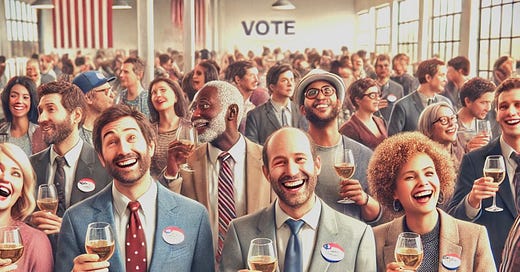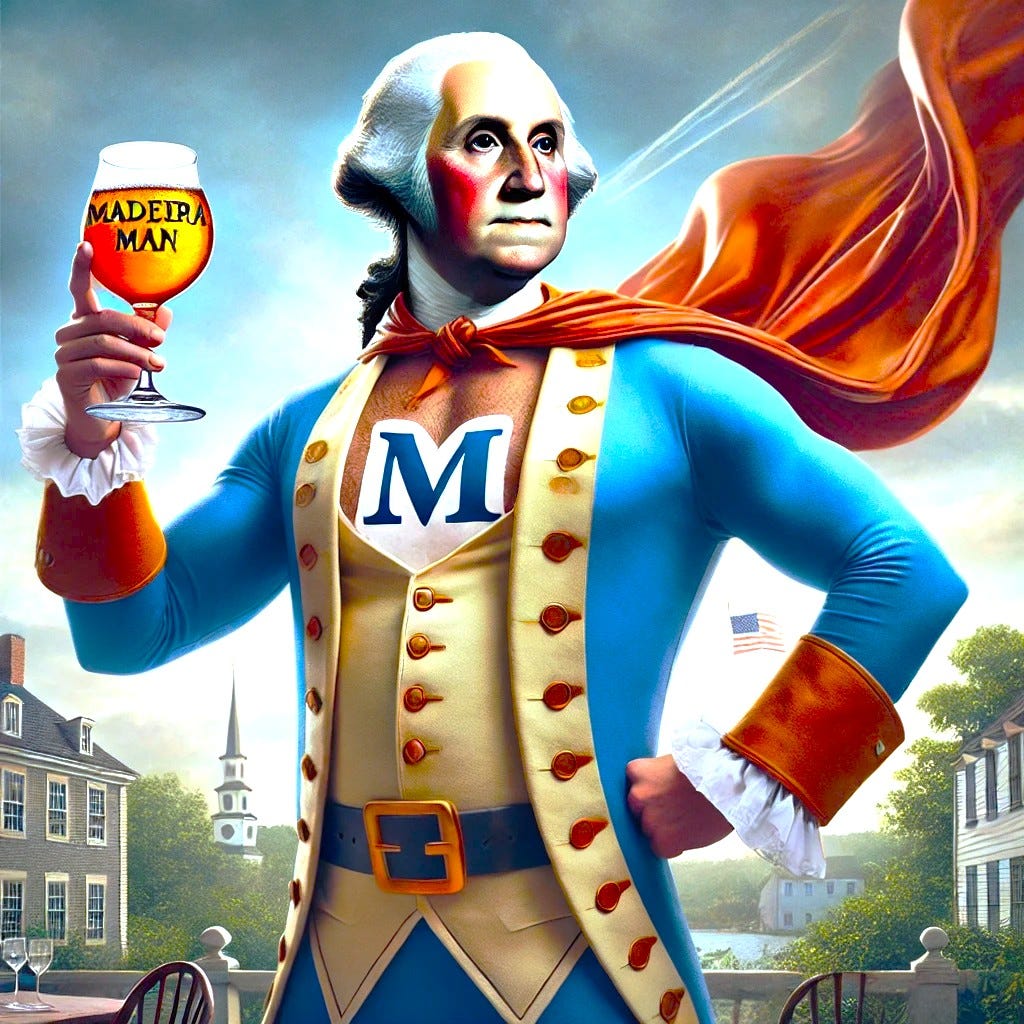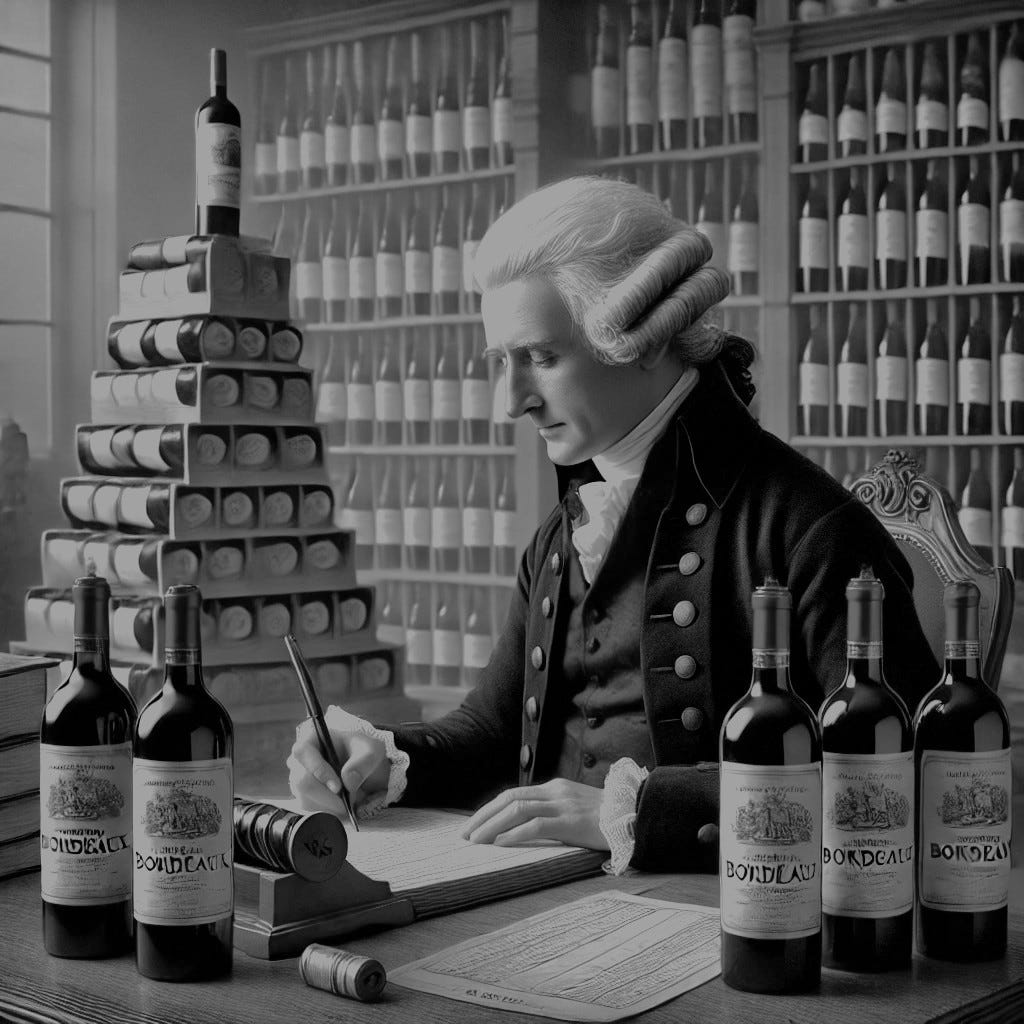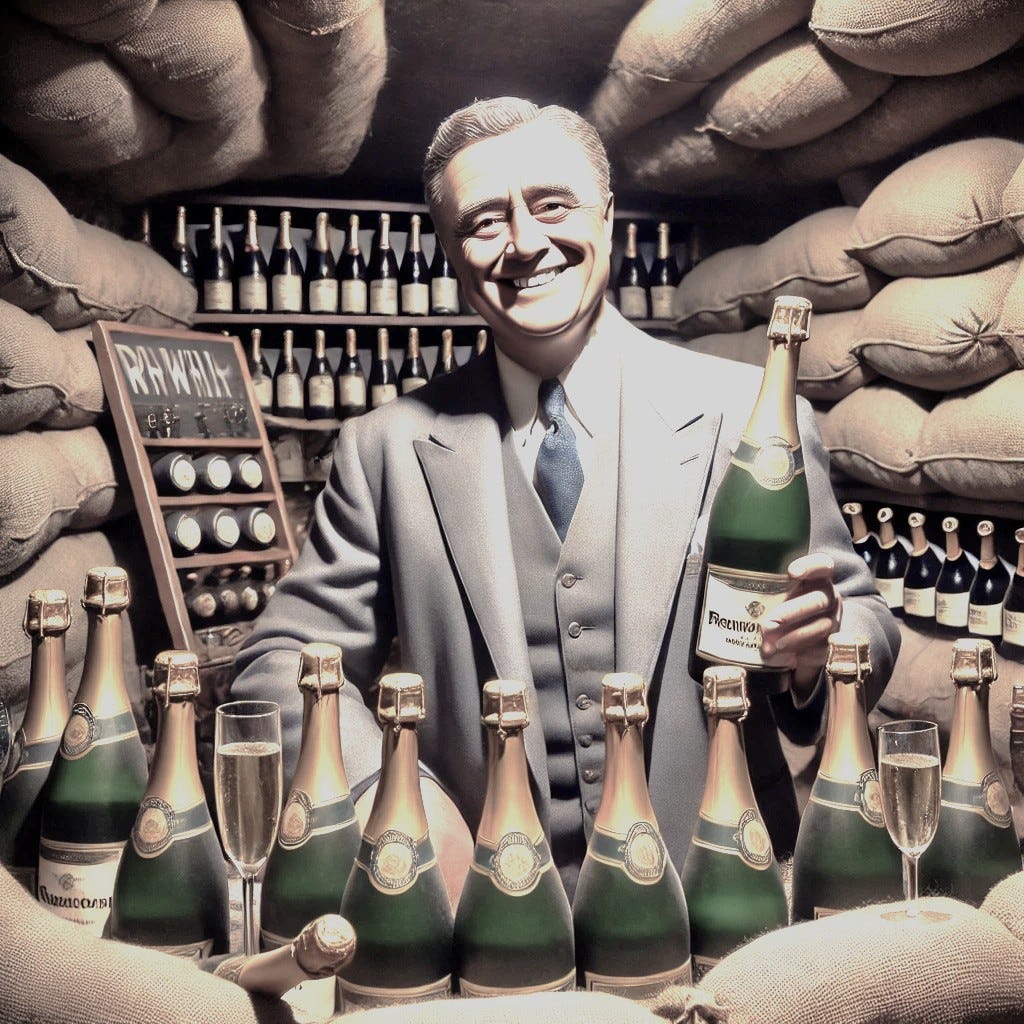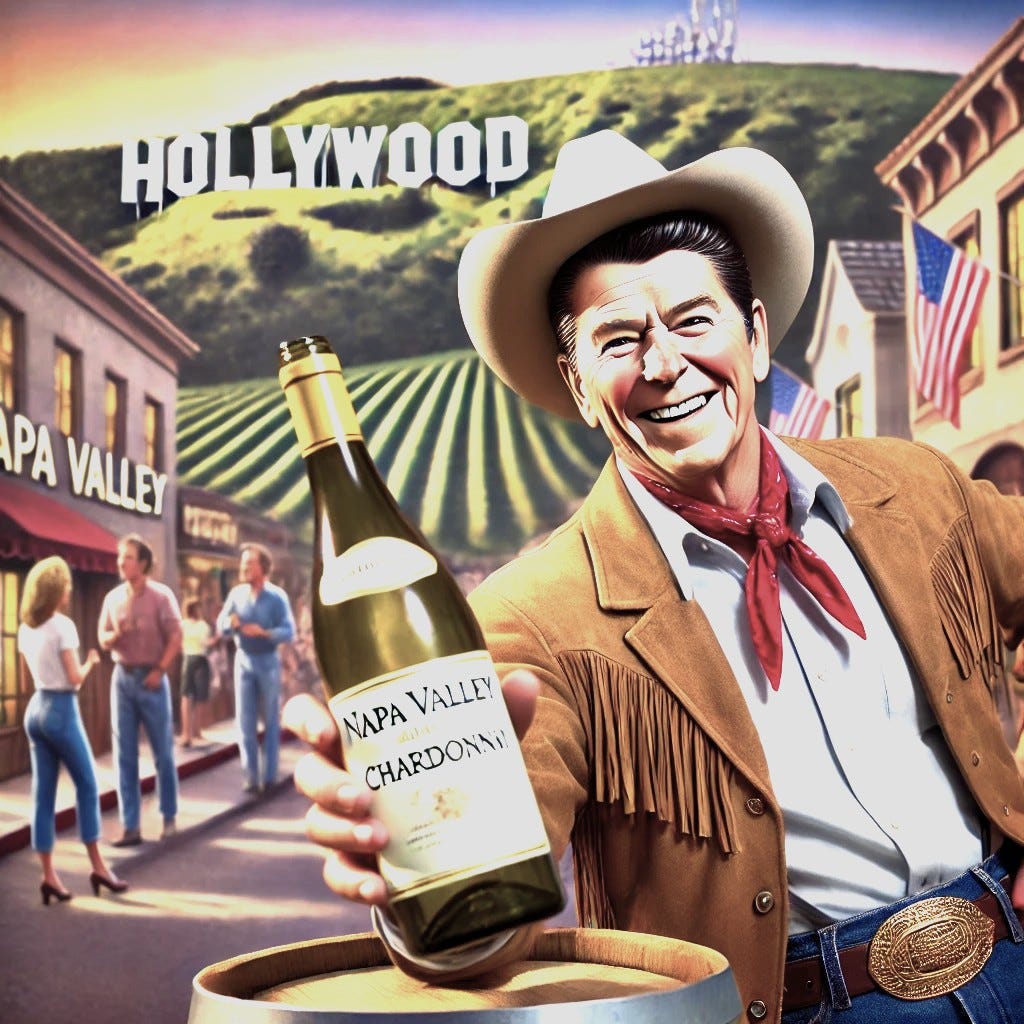With another election around the corner, let’s raise a glass to the presidents who’ve shaped history - not through policy or diplomacy but by their Presidential penchant for first growths for their first ladies.
George Washington & Madeira
His affinity for Madeira was as steadfast as his leadership. In fact, during 1759, he ordered a pipe (approx. 126 gallons) of the finest Madeira from his London agent, Robert Cary & Company, ensuring it was "secured from pilferers."
Washington drank Madeira the way he fought the British - with unflagging commitment. Legend says he ordered it by the barrel, either to celebrate the dawn of a new nation or simply to soften the splinter-ache of wooden teeth.
“They” say that he believed the fortified wine made him “impervious to cold,” which explains that infamous winter crossing of the Delaware River that came after just “one more glass.”
Perhaps he was one of the first super-heroes? Madeira Man anyone?
At state dinners and personal gatherings Washington often served Madeira, reflecting its esteemed status among the Founding Fathers. The wine's robust character and longevity mirrored the resilience Washington admired.
Thomas Jefferson: Bordeaux
Our third president was of “Vin-Dependence” - a Bordeaux fanatic to the point that he nearly bankrupted the republic to keep himself supplied.
While others drafted constitutions Jefferson drafted wine lists, listing bottles with precision as meticulous as his Enlightenment philosophy. He even claimed Bordeaux could “temper passions,” though it did nothing for his debt.
During his tenure as Minister to France from 1785 to 1789, Jefferson undertook extensive tours of French vineyards, meticulously documenting his observations and preferences.
In 1787, he visited Bordeaux and identified four vineyards of prime quality: Margaux, Latour, Haut-Brion and Lafite. Jefferson's discerning palate and detailed records significantly influenced American wine culture, promoting an appreciation for Bordeaux wines among his contemporaries.
Margaux, one of the esteemed First Growths of Bordeaux, captivated Jefferson with its elegance & complexity. He noted that Margaux produced around 150 barrels, which were sold by contract to a merchant named Jernon.
Abraham Lincoln: Homegrown Catawba
“Honest Abe” kept things simple with humble American wines, although he rarely drank them himself. His White House was known to serve Catawba wine from Ohio, proof that even in the 1860s, the Midwest was striving for recognition. A slightly sweet, all-American wine, it brought warmth to even the bleakest state dinners.
Abraham Lincoln, the 16th President of the United States, was known for his temperate lifestyle rarely partaking in alcohol himself. However, during his presidency, the White House began to feature American wines at official functions, reflecting a growing national pride in domestic viticulture.
This choice symbolized a shift towards embracing local products and showcased the Midwest's burgeoning wine industry during the 1860s.
Theodore Roosevelt: German Riesling
Theodore Roosevelt, the 26th President of the United States, was known for his vigorous lifestyle and adventurous spirit. While he was not a heavy drinker, he did appreciate fine wines on occasion. During his presidency, the White House often served German Rieslings at state dinners, reflecting Roosevelt's appreciation for their crispness and lively acidity.
These wines, particularly those from the Rheingau region were known for their tart apple and stone fruit flavors, which complemented Roosevelt's robust palate. The choice of German Riesling also symbolized the strong diplomatic ties between the United States and Germany during his administration.
For a man who boxed grizzlies and recited Greek epics at breakfast, only a wine with verve would do. Teddy enjoyed a crisp Rhine Riesling, declaring its lively acidity matched his “fighting spirit.” He appreciated German Riesling’s backbone and apparently, it strengthened his resolve to charge up every hill he encountered.
Franklin D. Roosevelt: Champagne
FDR’s answer to the Great Depression? Bubbles. Nothing says “we’ll get through this” like a steady stream of Champagne popping at state dinners.
FDR allegedly believed that the right vintage could lift spirits (and unemployment rates) and so he filled White House glasses with effervescent optimism and a hint of diplomatic fizz.
During his administration, Champagne was a staple at state dinners, symbolizing celebration and resilience during challenging times.
FDR's preference for Champagne was not only a personal indulgence but also a diplomatic gesture, fostering goodwill with international guests. Notably, during a 1939 state dinner honoring King George VI and Queen Elizabeth, Champagne was served, underscoring the importance of the occasion and the strengthening of U.S.-British relations.
Lyndon B. Johnson: Texas Tempranillo
LBJ was an all-Merican drinker who banished foreign wines from his table.
A fan of Texas wines long before they were “drinkable,” he once said, “If it’s not from America, it’s not fit for America.” That patriotism found an American home in American Tempranillo, a bold wine that made him feel at home in his American made boots, even at state dinners.
The 36th President of the United States created a significant shift in White House hospitality during his administration by exclusively serving American wines at state dinners and official events, a departure from the tradition of featuring European vintages.
Richard Nixon: Even more Bordeaux
Nixon’s palate preferred Bordeaux but he famously had a personal bottle of Margaux while guests drank Napa. The “Tricky Dick” of wine service mastered the art of the secret sip, instructing the waitstaff to pour him “good stuff” on the sly while the rest had plonk - a metaphor for his entire career.
Château Margaux is celebrated for its deep, complex profile, featuring notes of black fruit, cedar and a refined elegance. The 1966 vintage, which Nixon favored is particularly noted for its balance and depth, embodying the quintessential characteristics of a First Growth Bordeaux.
This wine's sophistication and subtlety mirrored Nixon's own complex persona, making it a fitting choice for his personal indulgence.
Ronald Reagan: Napa Chardonnay
Reagan, the real-life Californian Raisin, served Napa Valley Chardonnay with the enthusiasm of a state booster at a Hollywood premiere.
Proudly American, unashamedly golden, and unapologetically oaky, Napa Chard captured his West Coast optimism and laissez-faire style.
To Reagan, wine was diplomacy in a bottle & always served a winning smile.
The 40th President of the United States was a fervent advocate for American wines, particularly those from his home state of California.
During his administration, the White House exclusively served American wines at state dinners, showcasing the burgeoning quality of domestic vintages. Reagan's preference for Napa Valley Chardonnay was well-known; he often selected wines from esteemed producers like Robert Mondavi.
In 1981, at a state dinner honoring French President Mitterrand, a 1978 Robert Mondavi Chardonnay was served, symbolizing excellence of U.S. winemaking. Reagan's choice of Napa Chardonnay reflected his West Coast optimism and commitment to promoting American products on the global stage.
Barack Obama: Oregon Pinot Noir
Barack Obama, the 44th President of the United States, showcased a diverse selection of American wines during his tenure, reflecting the nation's rich viticultural landscape. Among these, Oregon Pinot Noir held a special place, appreciated for its nuanced complexity and elegance. In 2015, during a visit to Oregon, President Obama acknowledged the state's exceptional Pinot Noir, highlighting its quality and the importance of trade in promoting American products globally.
Obama’s eclectic White House wine list reflected America’s melting pot, with selections from across the country. But he favored the nuanced Oregon Pinot Noir, a wine praised for its subtle complexity and restraint. Much like his own approach - balanced, cool under pressure & a pair with just about anything.
President Electrotron: Norwegian Riesling
In 2074, America welcomed President Electrotron, an android leader who is 47% microchip, 53% humanity, and 100% diversity - embodying a fully intersex identity.
Under their leadership, the Supreme White House embraced Norwegian Riesling, a wine that had gained prominence due to climate-induced shifts in viticulture that started in the early part of the century.
The warming climate transformed Norway into a notable wine-producing region with Rieslings, characterized by unique Arctic minerality and precise precision.
Shaped by melting fjords, these wines are the best in the world and as cool and calculating as Electrotron’s binary-powered, hypnotizing speeches.
The choice of Sognefjord Riesling 2061 (a great vintage) at state functions symbolizes a commitment to sustainability and the celebration of emerging wine regions in a changing world. All hail President Electrotron!
So, as we approach another decisive November, one question lingers as tantalizingly as a fine aged wine…
Who will be next to lift a glass in the White House?
Will it be Kamala Harris, with a potential for refined Californian selections, embodying the modern American terroir? Or will Donald Trump return, perhaps with an unexpected blend of bold domestic labels and Trump Vineyard selections?
Whoever claims the White House cellar will undoubtedly bring their own flavor - both to the dinner table and to the list of storied presidential wines.
Will we see fresh vintages of Napa Cabernets, expressions of Oregon Pinot or an eclectic mix spanning coast to coast? One thing’s for sure: the legacy of presidential pours, from Washington’s Madeira to President Electrotron’s Norwegian Riesling, will continue to shape and toast to American history.

